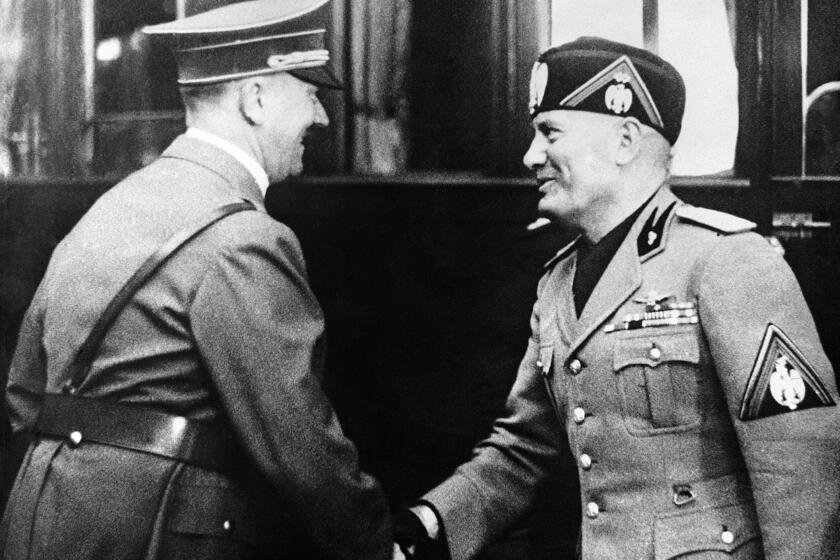Trump says criminal activity is genetic. Nazis showed where such talk can lead

- Share via
In a recent interview, Donald Trump claimed that 13,000 “murderers” have been admitted to the United States through an “open border.” He continued that for murderers, “it’s in their genes. And we’ve got a lot of bad genes in our country right now.”
That criminal activity is rooted in an offender’s genetic makeup is an old, largely discredited idea. For Trump to spout questionable science is hardly new. But the disturbing implications in what he said raise the specter of far worse crimes than anything one murderer could do.
Don’t normalize this: Trump, who aspires to lead a diverse nation, keeps crossing the line into theories that the Nazis embraced.
The Italian physician and criminologist Cesare Lombroso came up with the idea of the “born criminal” in the 1870s. Lombroso thought that criminals were “primitive” humans born into the modern world — identifiable by their thick hair, dark skin and small craniums. Reflecting the racism of his day, he equated criminals to Africans, Indigenous Americans, Sinti and Roma, even southern Italians. In the fifth and final edition of his book, “Criminal Man,” he concluded that the “struggle for existence” should “shield us from pity” for born criminals, who were “not of our species but the species of bloodthirsty beasts.” Ironically, his criminology became a justification for mass killing.
In the early 20th century, Lombroso’s ideas gradually fell out of favor. But they made a comeback in Germany under the Nazis, as what the Nazis called “criminal biology.” When the Nazis got control of German police, criminal biology became their paradigm for identifying and punishing lawbreakers.
For the Nazis, the role of the criminal police was not only to catch crooks after the commission of an offense but to engage in preventive crime fighting. The Nazis’ criminal police were empowered to send anyone they suspected might commit a crime in the future to a concentration camp — based on their supposed criminal biology.
Trump told evangelical Christians they won’t have to vote anymore. Autocrats have long seen elections as an unacceptable way for one’s political fate to be decided.
And Nazi leaders spoke about criminals — especially repeat offenders — with clearly murderous intent.
In 1935, Hans Schneickert, a senior Berlin police official, wrote that criminal policy was about the “eradication of life unworthy of life,” which meant genetic criminals. The phrase “life unworthy of life” had been coined just a few years before by a prominent professor of criminal law.
The head of all criminal police in Nazi Germany, Arthur Nebe, wrote in 1939 that a criminal should not be given any “opportunity to carry his terrible genes into the community and to breed criminals unhindered.” Nebe’s deputy, Paul Werner, added that “if a criminal or asocial person has [criminal] ancestors,” his behavior was “hereditary,” and “a change cannot be achieved through educational influences. Such a person must therefore be dealt with in a different way.”
Those who liken Trump to Hitler aren’t talking about World War II or the Holocaust, but how a dictator stoked fear and anger to gain power.
Nebe’s police began working closely with Robert Ritter, a medical doctor who made his name with research on the supposed criminal habits of generations of Sinti and Roma, and with his strange obsession with the “Jenisch” people — a Sinti-related group that Ritter held to be “a residue of primitive tribes” and responsible for most crime.
Two things are important here: first that the Nazis racialized criminals, holding that lawbreakers were defined by their genes and closely related to the Sinti and Roma, the Jenisch and the Jews. And second, that Nazis took the next step: This racial group had to be “dealt with in a different way” — in other words, killed.
The Nazis created “Special Courts” to administer speedy trials with no appeals, in order to “render harmless,” “eradicate” and “exterminate” their defendants. Criminals, or even suspected criminals, could also be sent to concentration camps. Eventually those camps started administering what they called “annihilation through labor.”
It didn’t stop there. Nebe’s crime lab began experimenting with gas chambers using carbon monoxide. These chambers were used to kill people with mental and physical disabilities. When Germany invaded the Soviet Union in 1941, Nebe went east to command what the Nazis called an Einsatzgruppe — a task force — with the mission of shooting “saboteurs,” “plunderers” and Jews, in inconceivable numbers. He brought many criminal police officers with him. This was the first form of what we now call the Holocaust.
When mass shootings proved too stressful for Einsatzgruppe personnel, Nebe remembered the gas chambers his lab had developed and began experimenting with them again. This was the technology of the Holocaust as we usually think of it. Most people whom the Nazis executed in gas chambers were killed with carbon monoxide. Nebe and his criminal police were the architects of this form of mass killing.
Once this model for racializing “criminals” and the technology to kill them en masse had been developed, the Nazis had no trouble shifting it to the killing of people with disabilities, the Sinti and Roma, LGBTQ+ people and, of course, Jews.
When Trump makes statements about genetic criminals — especially when he equates criminals with immigrants and ethnic minorities, and talks about giving the police “one really violent day” to deal with them — we should worry. We know the grim truth about where racializing, criminalizing and pre-genocidal language can lead.
Benjamin Carter Hett is a professor of history at Hunter College and the Graduate Center, CUNY. His latest book is “The Nazi Menace: Hitler, Churchill, Roosevelt, Stalin, and the Road to War.”
More to Read
A cure for the common opinion
Get thought-provoking perspectives with our weekly newsletter.
You may occasionally receive promotional content from the Los Angeles Times.












